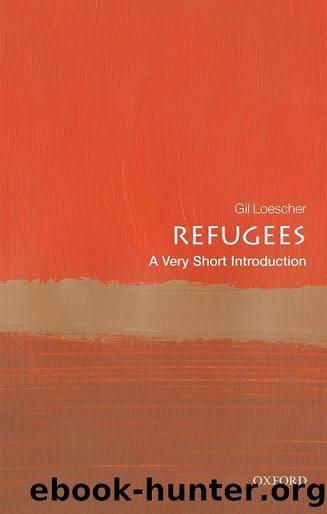Refugees: A Very Short Introduction by Gil Loescher

Author:Gil Loescher [Loescher, Gil]
Language: eng
Format: epub
ISBN: 9780198811787
Google: DRUuEAAAQBAJ
Amazon: 0198811780
Publisher: OUP Oxford
Published: 2021-05-26T23:00:00+00:00
Chapter 4
Responding to refugee movements
When governments created a system for responding to the needs of refugees, they agreed on the principles and institutions necessary to provide protection for refugees and to find a solution to their plight. As discussed in Chapter 2, the fundamental principles are detailed in the 1951 Refugee Convention. The core institution of the system is UNHCR. Together, these instruments are supposed to ensure that refugees have access to key rights while they are in exile. They are also supposed to help refugees find a solution to their plight.
Because refugees are individuals who have fled their home country and no longer enjoy the protection afforded to citizens of a state, the 1951 Refugee Convention also sets out the rights to which all refugees are entitled, namely that refugees should have access to national courts, the right to employment and education, and to a host of other social, economic, and civil rights on a par with nationals of the host country. UNHCR also has responsibility for monitoring and supporting statesâ compliance with these rights. As we saw in Chapter 2, UNHCR has a long history of protecting and assisting millions of refugees and other displaced people around the world. For decades, the international structure for the protection of refugees provided a global treaty framework which (with some major exceptions) assisted and protected many refugees in Europe, Africa, Latin America, and most of Asia and North America.
Since its creation in December 1950 by the UN General Assembly, UNHCR has had a specific mandate, namely to ensure that refugees have access to protection from persecution. The framers of the UNHCR mandate also set out a range of âdurable solutionsâ aimed at resolving refugee problems. These solutions include resettlement in another country, local integration in a nearby receiving country, or repatriation to their home countries when conditions are safe enough for refugees to return and reclaim their rights in their country of origin.
However, the global refugee system is not able to do this work on its own. Instead, every element of the system was designed around the understanding that governments would cooperate with the regime and each other to make the system work. UNHCRâs 1950 statute does not give the organization the authority to work on its own. Instead, it works under the authority of the UN General Assembly, which is made up of states. UNHCR cannot provide solutions for refugees on its own. Instead, it is mandated to assist governments in finding solutions and can only implement solutions with the approval and cooperation of governments.
The entire logic of the global refugee system is premised on the cooperation of states. In fact, the preamble of the 1951 Convention notes that âthe granting of asylum can place unduly heavy burdens on certain countriesâ, that the issue of refugees is âinternational in scope and natureâ, and that protection and solutions for refugees âcannot be achieved without international cooperationâ.
While states have reaffirmed their commitment to the idea of international cooperation dozens of times over
Download
This site does not store any files on its server. We only index and link to content provided by other sites. Please contact the content providers to delete copyright contents if any and email us, we'll remove relevant links or contents immediately.
| Africa | Americas |
| Arctic & Antarctica | Asia |
| Australia & Oceania | Europe |
| Middle East | Russia |
| United States | World |
| Ancient Civilizations | Military |
| Historical Study & Educational Resources |
The Third Pole by Mark Synnott(914)
Money for Nothing by Thomas Levenson(898)
The Economist (20210109) by calibre(897)
Christian Ethics by Wilkens Steve;(824)
Made in China by Anna Qu(811)
The Age of Louis XIV: The Story of Civilization by Will Durant(788)
Reopening Muslim Minds by Mustafa Akyol(768)
Nonstate Warfare by Stephen Biddle(766)
100 Posters That Changed The World by Salter Colin T.;(750)
Culture by Terry Eagleton(722)
The Shortest History of China by Linda Jaivin(721)
The Great Pyramid Void Enigma by Scott Creighton(721)
The Irish Buddhist by Alicia Turner(716)
Ideology by Eagleton Terry;(696)
Routledge Handbook of Contemporary India by Knut A. Jacobsen(694)
Sybille Bedford by Selina Hastings(656)
The Jews of Silence: A Personal Report on Soviet Jewry by Elie Wiesel(650)
Objects of Vision by Saab A. Joan;(639)
Banaras: CITY OF LIGHT by Diana L. Eck(631)
